10
Training Syllabus
From the simple initial purpose of ‘training selected categories of personnel for appointment as regimental officers in the ARA’, enunciated by the Military Board in 1951 (1), the OCS curriculum for the 22 week course was developed. There were the syllabuses of the wartime short officer courses, RMC wings, officer qualifying courses, overseas colleges and RMC to lean on, plus the innate knowledge of the essentials for producing the essential basics of drills, skills, tactics, administration and general military knowledge necessary for a professional junior regimental officer which guided selection of the must-haves from the should-haves and could-haves from this wide shopping list. The fact that entrants without basic military training were given that at a preliminary course at the School of Infantry from the second course onwards, and all graduates undertook a corps training course after graduation, reduced the scope to be covered, which was centered on the infantry platoon commander level. During the period of the six short courses there were refinements which rebalanced time allocation as the preliminary course removed some of the most basic training needs, and experience showed minor weaknesses, but introduction of the full year course provided a new dimension which allowed the admission of the should-haves and some of the could-haves, with a broader definition of the Charter to guide this restructuring (2):
- The aim of the School is to give a balanced introductory education in basic military subjects to each Officer Cadet for the commencement of his career as a commissioned officer in the Regular Army, and to foster in him the mental and moral qualities on which leadership depends.
- Towards the realisation of this aim, the school curriculum is designed to:
- Promote a sense of honour, loyalty and responsibility;
b. Inculcate habits of discipline and soldierly conduct;
c. Develop the capacity for logical thought and clarity of expression;
d. Teach the basic military skills and techniques of modern warfare required of the junior regimental officer, and the organisation, roles and employment of the various Arms and Services of the Army.
This aim was quite achievable within the full year course, which provided a comparable coverage of military subjects to that at Duntroon, and feedback from units confirmed graduates in their first appointment to have satisfactory knowledge. The Wade Committee in 1959, while recommending OCS’s permanent retention with a 12 month course, considered two years necessary to give a cadet the broader knowledge required beyond his first appointment (3). This was hard to justify quantitatively, as the amount of theoretical military instruction which could be absorbed and be useful in an officer’s early years was limited, particularly until he had some practical experience to underpin and confirm basic knowledge and advanced instruction, which meant that this should occur after a period of commissioned service. In recognition of this the army routinely exposed all officers to a succession of basic and advanced administrative, technical and tactics courses, promotion examinations and staff colleges designed to give them a progression of theoretical knowledge to match their career paths and keep abreast of current developments. A possible justification was broadening of non-military education as part of the officer development process, but RMC was already in this field. OCS had been continued on, after the original purpose of delivering an immediate stream of junior officers was achieved, as an alternative to the RMC academic stream. As Lt Gen Sir Thomas Daly put it in the inaugural Harrison Memorial Lecture (4):
I had been a member of Duntroon selection boards and was often distressed and disappointed when young men who clearly possessed outstanding leadership potential were discarded because of their marginal academic attainments. It seemed little short of criminal that the Army should lose these motivated young men who would, in all probability, develop into excellent junior leaders of the type that the Army needed so urgently and there was little doubt in my mind that the best of them could eventually outstrip many of their more academically gifted colleagues.
Life on the run – PMC’s Lawn, 1974
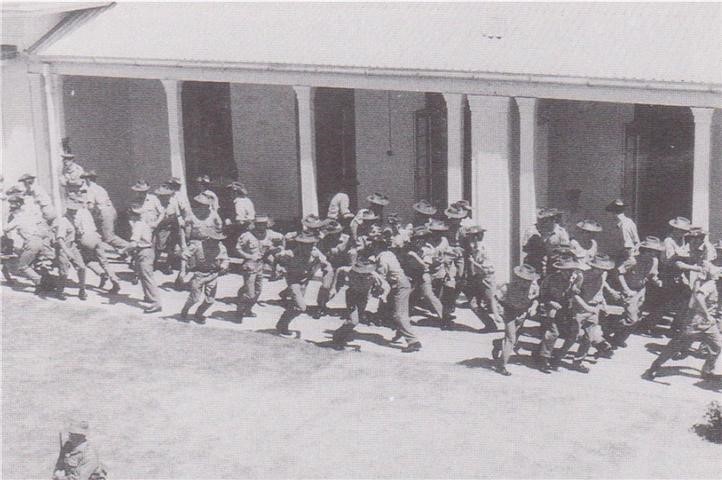
Dismissal of cadets from one activity initiated a frantic rush to get to the next, often a radical change of dress and equipment with five minutes to do it in: the Leaps training inflicted by the senior class on the juniors did have practical benefits.
While there were several benefits in accelerated programmes, there are also limits in absorption for long term instruction.
Softening of the approach from the late 1960s was accompanied by a doubling of the failure rate, succeeded by a redoubling of the teaching rate in an attempt to reduce the wastage rate to its earlier level.
OCS Scrapbook 1974
The Military Board was sufficiently unimpressed with any extension to confirm the one year duration, leaving the School’s charter and course content as they stood. It was, however, resurrected in a 1967 comparative review of the place of RMC and OCS in the officer production field which, as well as concluding that Portsea was progressively taking over as the major source of Staff Corps officers, also noted that its graduates were matching those of Duntroon in attendance at staff colleges and consequently also in promotion opportunities, so coming to the conclusion that it should also more nearly match RMC in training time with a two year course. This proposal was circulated by the Adjutant General at a time when the army was preoccupied with supporting the force in Vietnam: extension of time in the training pipeline, with officer production already well behind the 1963 targets, was the last thing that was needed. In consequence it died a very natural death, particularly as the figures used to press home the point that OCS graduates were successful in matching their colleagues in gaining advancement demonstrated not that more training was required, but apparently that which they were receiving was very adequate (5).
The Charter went through some further changes in accordance with the tastes for expression in particular periods, which did not change the underlying concept of officer training which had been well established for half a century, finally ending as (6):
The Charter of OCS is to train cadets for service as officers in the Australian Regular Army. Its aim is to give them the knowledge necessary to fit them for this service, and to foster the moral and mental qualities on which leadership depends. The course of instruction is designed to:
- promote a sense of honour and loyalty, duty and responsibility; inculcate habits of discipline and soldierly conduct; and give a correct understanding of the place of the Armed Services in the Australian Nation;
b. develop a capacity for clear and logical thought and expression;
c. give a sound military education in the science and art of war; and
d. instruct in the military skills and techniques of modern warfare required of the junior officer.
Accompanying this was an apparent expansion of the content of the syllabus in the mid1970s from the previous average of 2,500 periods to 4,000. This was in itself largely cosmetic. Much of the field instruction was transferred from the heading of Infantry to those of Battlecraft and Tactics, while the additional 1,500 periods were generated by bringing such previously extra-curricular activities as leave, sport and administration into account, and with a two week extension to 46 weeks in 1982, the end total matched the RMC total of about 4,000 periods for military subjects, which put to rest any further arguments of disparity requiring an extended course (7).
Battle Training – Close training area 1961
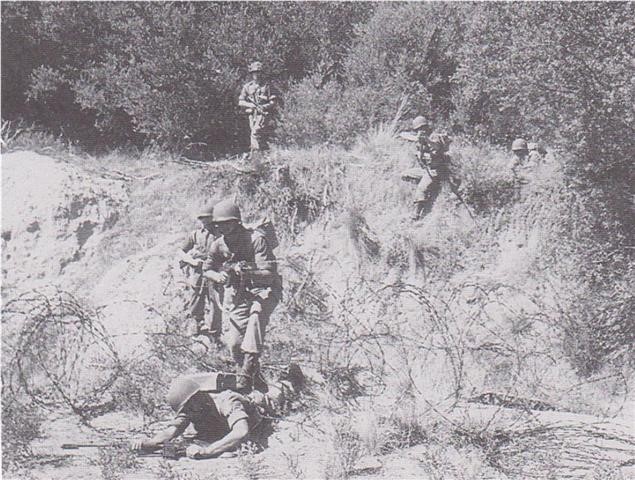
Before entering the phase of continuous field training, students had to be practised in the basic drills and skills which were the building blocks of minor tactics.
These cadets practising obstacle crossing were recently reequipped with the self loading rifle, the US pattern helmet had arrived, and the Australian pattern high gaiters had replaced ineffective anklets, but there remained the 1937 pattern webbing.
The haversacks they are carrying are noticeably square, as they were required to be displayed that way when hung up in cadets’ rooms, getting that shape by insertion of flat stiffening boards or similar, and taken that way into daily local use to avoid disturbing their shape. It was not until field training proper that packing of webbing took place.
OCS Scrapbook 1961
What was more germane than the charter was how this basic philosophy was implemented in terms of course content and emphasis. As is demonstrated in the block syllabuses in Table 9 there were some significant swings in the allocation of time to reemphasise areas more deserving of attention, resulting partly from broader needs in an increasingly sophisticated army, partly from the preferences of commandants and chief instructors, and partly through the introduction of such specialists as education officers and psychologists who had their own angles to push; the days of officer training being the transmission of knowledge and philosophies from experienced line officers and warrant officers to students were passing. As commandant Col G.D. Burgess observed, there was always a proponent of adding additional material to the curriculum, either new or expanded topics, without any compensatory reduction in other subjects. This, if agreed, meant added pressure on the cadets to absorb more, and resulted in extended hours of work for both staff and students.
The elastic could stretch so far, and as is the case in all training, civil or military, the first hurdle is unevenness of initial knowledge, where an appreciable part of training courses is absorbed in achieving some basic parity from which to proceed. This was at the root of the problem at OCS, where virtually the first half of the full-year course was devoted to producing a trained soldier, the second to officer training. This had been partly attacked at the end of the first course with the short pre-OCS course at the School of Infantry introduced for civilian entrants to get all students to a minimum knowledge of basics, but this was merely scratching the surface. The cosmetic upgrading of numbers of periods to match RMC’s effective 18 month military component by including administrative and recreational content in official time, could not get away from the deficiency in the real content, and this was recognised in the combined course for 1986 which covered a year and a half, the first six months for basic training from which those with a full level of basic training could be exempted. The remaining year provided the necessary scope for a balanced officer education at a sustainable pace as opposed to the OCS one which had been extended in 1955 to allow a balanced programme, then progressively brought back to nearly the same hectic pace with the progressive introduction of more and more instructional material (8).
Living in the field – 1969
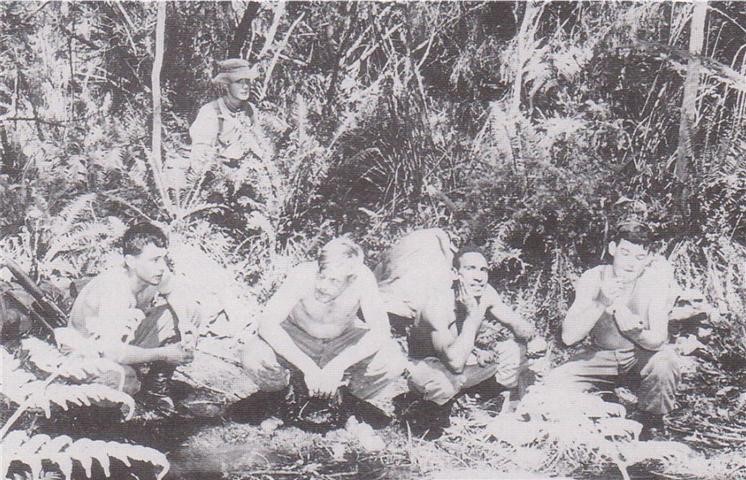
Australia’s early soldiers came from bushmen to whom camping out was second nature. When they came to be recruited substantially from the city, it became necessary to teach elementary personal arrangements like hygiene, field shelters, making fires and self-cooking, as well as such group tasks as erecting tents, garbage disposal, sullage and latrines.
Some matters were taken up with religious-like fervour. While rigid water, anti-mosquito and parasitic disease precautions and weapon maintenance were no more than survival necessities, daily shaving and cleaning footwear were also enforced on the basis that they lifted morale.
A group of cadets is here lifting its morale during camp training at Mullungdung State Forest near Yarram.
OCS Scrapbook 1969
Drills and Skills
Before getting an officer the army first had to get a soldier. A proportion of the entrants was drawn from serving soldiers who at various times comprised Regulars, CMF and National Servicemen, and some had extensive experience in the School Cadets before they lost their military value; but many entrants had no prior military experience. All had to be remoulded to the special values, standards and way of life of an exacting profession; those with some prior experience simply did it more easily.
Swimming tests – The Pier 1966
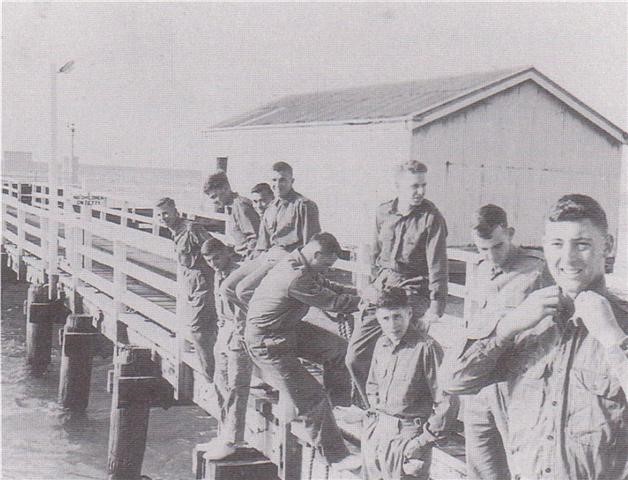
Part of the basic soldier proficiency tests, all students were required to pass elementary tests in notation and swimming clothed and unclothed.
The School was never endowed with its own swimming pool, use for normal swimming having to be made of borrowed pools at Flinders or hired pools at Rosebud or, for major carnivals, Melbourne.
The tests were conducted from the Pier until its demolition as unsafe and beyond economical repair in 1973. Thereafter the pier at Portsea was used. Word of their being held always leaked out and the Portsea Pub was packed with locals eager to see the sport while fortifying themselves against the cold. A sentry with a rifle kept watch as a precaution against shark attack while the cadets were in the water.
OCS Scrapbook 1966
A primary aspect of the basic soldier element was to make the cadet physically fit and alert, with a pervasive amalgam of gymnasium work, track and roadwork, and programmed sport. As commandant Col J.F. McDonagh commented, OCS had a generous allocation of physical training instructors and a high standard of physical fitness was achieved by cadets; another view of an adversary from the RAAF Academy at Point Cook was that they were fit as mallee bulls and always used it to the full in sporting competition. Yet there were always those whose fitness gave cause for concern and, more to the point for potential officers, those who had to be driven rather than making their own pace. For these the PT instructors had a special reward: the Scramble Track up the crematorium hill behind the gym, which had to be run by all classes, but could be used as a special extra for slackers; the other was introduction of a gym squad to accommodate in their own time those who had not met the test standard by the end of their junior class. The outcome of all these attentions was recognised as having improved performance not only in outdoor activities but also in the classroom (9).
Battle physical training – 1972
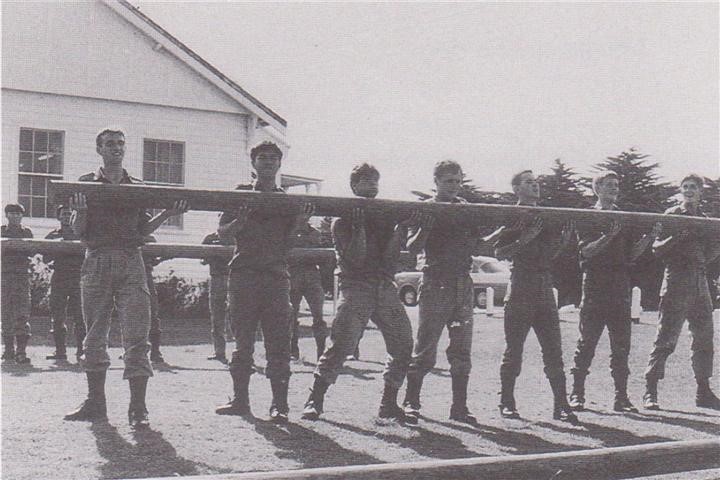
Physical training and effort could have many faces. Apart from gymnasium and trackwork, Battle PT, which could take any number of forms, combined physical exertion with team effort pushing trailers, pulling vehicles by rope, here lifting logs in unison, though some inequality of effort is observable.
With few opportunities lost to push physical fitness on a daily basis, cadets burned unusual amounts of fuel, and remained perpetually hungry. Commandants quite reasonably approved issue of the arduous duty ration supplement on a continuous basis when it was supposed to apply to short periods, and when this was queried by ‘higher authority, noted that cadets were regularly buying extra food from the unit canteen to augment what was a generous ration scale for normal activity levels.
OCS Scrapbook 1972
A second basic requirement was for cadets to be able to organise their life, living, clothes and personal equipment. Initially taken on by the warrant officer instructors, this became the province of the senior classmen who had to foster in protegees and bring them up to standard by informal means; that is until the induction training was set up separately from the COC from July 1983 when the non-commissioned staff resumed the role. Accompanying this was instruction in parade ground drill and proficiency in small arms. Then had to be added a whole range of activities, quite novel to those unaccustomed to the self-sufficiency demanded of army life and work: living in tented accommodation and in the field, fire drills, and health, hygiene and first aid, the latter conveniently accommodated for the junior class from 1961 by short courses at the School of Army Health at Healesville (10).
Basic medical training – Healesville 1980
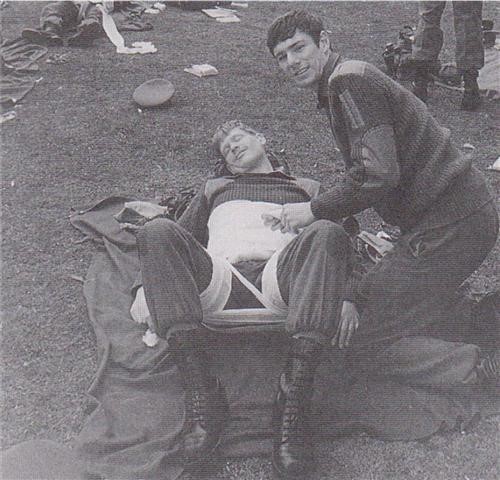
Hygiene and first aid training were conveniently effected by a three day course conducted at the School of Army Health. This was a popular visit as it got away from the School environment to a low pressure segment of training with instructors less activist than those at Portsea. Part of the programme was in dealing with a range of casualties, some of the efforts at bandaging and disposal being less than serious: L.A. Shepherd deals with supposed victim I.D. Cooke.
Another benefit was the opportunity for a recreational visit to the Healesville sanctuary, where overseas students had the chance see Australian wildlife, and if it was not totally wild, at least it was viewable at close range; not of cultural tour proportions, but still a welcome break in routine.
Photo: D.N. Thornton
When a high level of training at recruit level had been achieved, training in basics moved on to minor tactics, navigation, radio communication and ceremonial, parallel to an introduction to the functions of the various arms of the service. From thereon training advanced to provide the additional knowledge and skills to equip them to both operate effectively as junior leaders and commanders, and to train soldiers in basic and advanced skills. Much of this was by mutual instruction, where students prepared and delivered lessons to the others of their group, achieving both an advancement or confirmation of knowledge by all, and experience in instruction for the student instructor whose turn it was, with assistance and critique provided by staff assistant instructors. This was invaluable for newly commissioned officers when they took up appointments on graduation, usually in a recruit training or regimental unit where the climate was unforgiving of inability to instruct. One commanding officer of a National Service training battalion kept a bren gun in his office, and on interviewing a new young officer would require him to deliver a lesson on the weapon on the spot to test his ability as an instructor.
A further extension of knowledge and a broadening of understanding of the practical use of it was fostered by visits to army schools and units. A wide variety was covered, differing in scope at different times from a modest two-day trip to the Armour and Infantry Schools at Puckapunyal for the time-starved first course, gradually expanded to incorporate the School of Signals at Balcombe, and artillery and engineer demonstrations by 3rd Division at Puckapunyal; the latitude of the full-year course from 1955 permitted a more ambitious and rewarding visit to Sydney with 1 Fd Regt, the School of Military Engineering and 2nd Base Ordnance Depot. In later years a wide array of additional units was included on the shopping list: Armoured Centre, School of Artillery, School of Military Engineering, School of Signals, School of Military Intelligence, RAASC Centre/School of Army Transport, RAAOC Centre, RAEME Training Centre plus technical units and firepower-demonstrations (11).
Driver training – Nepean training area 1955
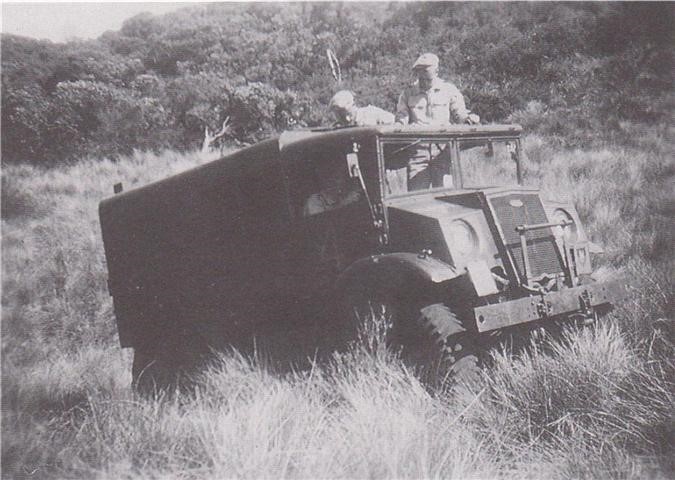
The driving and servicing wing of the RAASC School provided a 10 day driving course for the senior class as an extra module fitted into the longer course. While giving the cadets the opportunity to earn an army driving licence by accelerated training in driving, servicing, cross country operation and documentation, it also gave them the background for their later service in the running of army vehicles.
Like most army equipment of the time, the vehicles were carryover stocks from World War II. Poor road performers, unstable and erratic over 50 kph, they at least had good cross-country performance, here being tested by driver B.P. Fitzgerald, with passengers and advisers M.M. Easton and I.C. Teague.
Photo: I.C. Teague
The extended course also permitted introduction of an accelerated driving and servicing course by the visiting Mechanical Transport wing from the RAASC School to qualify cadets for their army driving licence. The need for junior commanders to be able to control supporting fire without the presence of a forward observation officer or mortar fire controller, as had been amply demonstrated in Korea, brought in a fire direction module from 1956 with 1st Field Regiment at Holsworthy, extending in later years to the provision of both a field battery and a mortar platoon. As time became available more subjects were packed into the syllabus: the extended course latitude of allowing the should-haves and some could-haves in with the must-haves brought a changed complexion as the former categories came to be regarded as must-haves, making it all the more difficult to discard or reduce them when new techniques and requirements had to be catered for. Some relief was afforded when local range facilities were constructed, and an improving RAAF air transport capability saved on travelling time, but there was always more to be covered without compensating time becoming available (12).
NBC Training – 1981
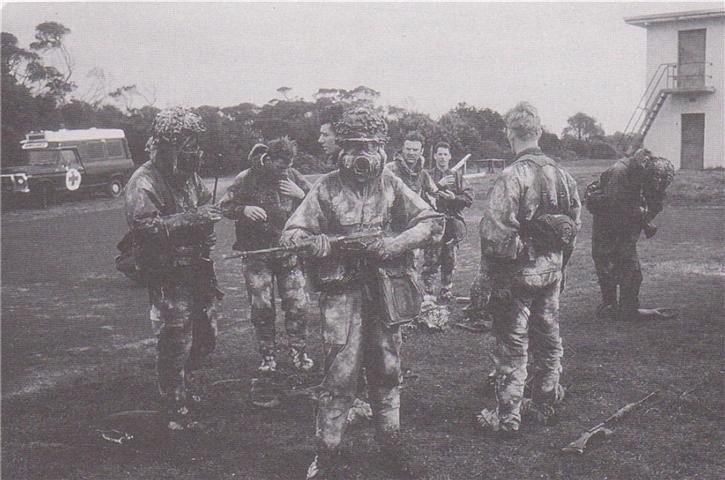
Instruction and practice in nuclear, biological and chemical warfare was a spasmodic event throughout the army. One of the negatives was usual lack of up to date equipment, it being farcical to teach primitive counter-measures against sophisticated threats.
Extended periods of minimum NBC threat ensured modem detection and protective equipment was low priority on equipment programmes. When limited purchase of any equipment was made, OCS was rarely at the forefront of units supplied with it. It was remarkable that an institution teaching future commanders and trainers should have been so often forced to teach on yesterday’s equipment. It was late in the day when useful chemical protection equipment became available at Portsea.
Identified: L.A. Shepherd, S.G. McGuigan, B.R. Read.
Photo: D.N. Thornton
This group of subjects attracted a range of prizes commensurate with their importance in the curriculum. Initially a single prize, increasing numbers on the courses gave latitude for a widening list, the most actively contested of which being the inter-company and inter-platoon shields:
The Field Prize
1952-71 Awarded to the cadet who gains first position in the combined aggregate in the following subjects [a selection of these applied at different times during the period]: Tactics, Drill and Ceremonial, Physical Training, Weapon Training, Map Reading and Field Sketching, Navigation, Radio Telephony Procedure, Photo Reading, Driving and Servicing, Mortars, Fieldcraft, ABC Warfare, Field Hygiene.
This prize was subsequently allotted as the Tactics Prize and its award is shown in Table 11.
The Basic Skills Prize
1971-85 Awarded to the cadet gaining the highest aggregate of marks for the following subjects [a selection of these applied at different times during the period]: Fieldcraft, Weapon Training, Battlecraft, Navigation, Physical and Recreational Training, Drill and Ceremonial, and Radio Telephone Procedure.
1978-85 as The Royal Australian Electrical and Mechanical Engineers Prize for Basic Skills
The Kiel Shield
1965-69 Awarded to the Company gaining the highest marks in [a selection of these applied at different times during the period]: Platoon marching, shooting, training tests. 1969-78 Awarded to the company gaining the highest marks in Minor Tactics.
1978-85 Awarded to the company gaining the highest number of points in the InterCompany Battle Efficiency Competition.
The P.J. Cook Trophy
1981-85 Awarded to the cadet gaining the highest individual score in the Senior Class Military Skills Competition.
The Skill at Arms Prize
1952-82 Awarded to the cadet gaining the highest aggregate score in range practices. 1983-85 Awarded to the cadet gaining the highest aggregate score in range practices and tests of elementary training.
The Rowell Shield
1955-85 Awarded to the platoon gaining the highest aggregate in military and sporting competitions.
The Royal Australian Army Medical Corps Prize
1981-85 Awarded to the cadet gaining the highest mark in Army Health and First Aid.
The major prizes for military skills subjects are shown in Table 10.
Field Training
Part of the selection criteria which made Portsea so attractive a locale for OCS was proximity to field training areas. The combined Defence and Quarantine Reserves provided space and terrain for not only the mandatory weapon training and range close training areas, but also allowed ample room for minor tactics at the platoon level to which OCS was directed. With the liability of a quarantine evacuation within 24 hours, any absences on field training in excess of this involved the pre- and post exercise task of boxing cadets’ possessions, so there was little attraction to look further afield when the immediate area was both satisfactory and eliminated travelling time. Consequently commandants Harrison and Cape both expressed themselves highly satisfied with Point Nepean as meeting the need, predicated also on the short periods of field training which they programmed; Jackson extended this to include nearby Langwarrin for greater scope and variety without a significant time penalty. When Ochiltree opted for a further horizon at Puckapunyal in the first half of 1957 it was done in the context of a two week period, and enabled greater scope for tactical and field firing exercises, as well as exercising the cadets in planning and implementing the setting up of a tented camp. There was also a coincidental ulterior motive as the plan for evacuation of the Quarantine Station was to Puckapunyal and this exercise provided a dress rehearsal for such a contingency (13).
There was a further incentive for training away when later commandants were confronted by much larger classes and so could afford the benefits offered by placing the platoons in company settings, requiring more territorial scope for enlarged exercises, and so began a move to larger training areas further afield, away from persistently adverse weather conditions at Portsea. This led to exercises at variety of state forests in southern and central Victoria. The state forest north of Healesville succeeded Puckapunyal camp, and remained the preferred location for the annual fortnight camp training for six years until increasing numbers of students put pressure on the area and Gembrook State Forest was added to rotate usage half year about. This however immediately led to further greener fields: first Broadford then Puckapunyal and Taggerty State Forests were added to provide variety, though the search for better midwinter weather eluded them: constant repetition of this theme was precursor to a 1968 overture for approval to move to kinder climes, a sentiment shared by most units in Southern Command and indeed a fair percentage of the population of Victoria, and therefore unlikely to succeed. The alternative was a switch from the central areas to Mullungdung State Forest near Yarram in the prospect that a coastal locale would be more equable; cadets not exposed to the rigours of the others could be forgiven for being equally critical of this area’s climate, but there it remained until a post-Vietnam change of policy from forward defence to defence of Australia switched army training from close country to open warfare, and OCS’s field exercises back to Puckapunyal (14).
Patrolling exercise – 1970
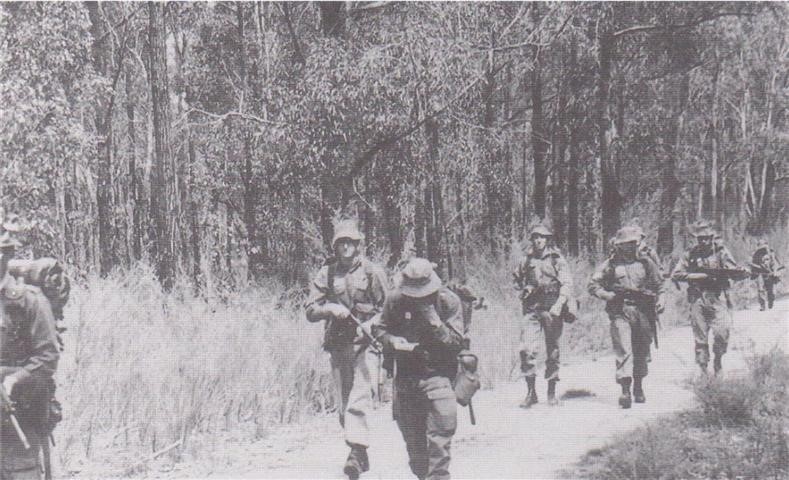
The emphasis given to close country fighting since the late 1950s became apparent when students were confronted with open space, having no concept of use of formations, scouts and bounds.
Close country reaction drills had replaced the basic concept of freedom of action, from which field formation and movement patterns flowed naturally. Behind this lay the limited horizons of the instructors. While the earlier ones at OCS were grounded in the open warfare era, later instructors had the background of counter-terrorist operations in Malaya or counter-revolutionary warfare in Vietnam as their guide.
The lack of appreciation of terrain changes demonstrated in the photo stemmed from teachings of the instructors and their lack of ability to both recognise and correct such dangerous errors. It was a knowledge won back with difficulty in the later 1970s.
OCS Scrapbook 1970
The first efforts at other than routine minor tactics were in conjunction with the RAN involving an amphibious landing from a corvette at Flinders Naval Base, good for a break from the confines of Portsea, but hardly either a good teaching medium or an example of good tactics; this set the scene for later exercises with the local navy, under the acronym of CADRAN. From short overnight bivouacs, field training was extended to a week, then in mid-1954 to 10 days, to allow continuity in exercising in a company setting in all phases of war. This was surprisingly reduced to a five and eight day period under the wider scope of the year course, but was progressively increased to two weeks at the end of each term as a final exercise and test for the graduating class, and confirmation of basic skills for the juniors. Originally open warfare training, the army’s switch to tropical warfare encouraged a bid to gain access to Canungra as had been arranged for RMC. This was not agreed and was offset by conducting tropical warfare training in close country at Healesville, which made that area attractive for some time until the better one was found at Yarram in 1969, when field training was consolidated into 16-day periods in each half year to give continuity to both the field and academic programmes, with a final week to consolidate and as a final test of knowledge (15).
APC deployment exercises – 1984
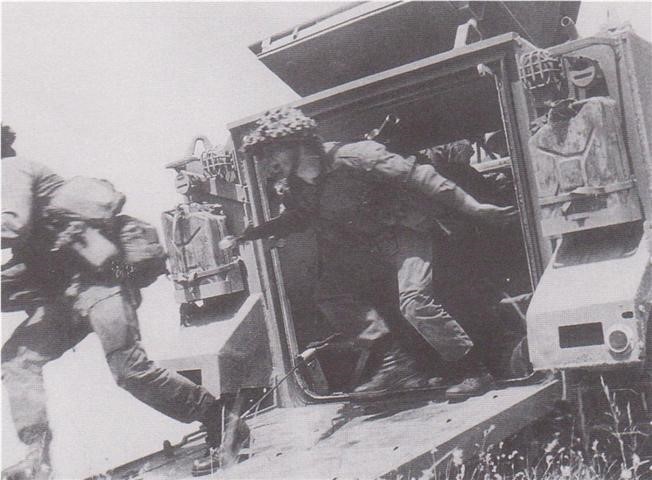
With the switch to continental defence, tactical exercises emphasised ground deployment against an enemy equipped for open warfare. Fortunately the army had a fleet of armoured personnel carriers, so regular and CMF armoured units were well equipped to provide such support.
There was a problem, however, in a whole generation of middle level regular officers who since 1957 had been training for close country warfare without an air threat, so that most commanding officers, company commanders and instructors had difficulty in the tactics and logistics of open warfare, and consequently teaching it, a comment made by commander of 1st Division Maj Gen P.H. Bennett in 1974.
A problem in a small army of relearning old types of warfare, this was minimised in the late 1970s by allotting different types of warfare to different brigades.
OCS Scrapbook 1984
From 1972 the core field training was extended to three weeks, but this finally overstretched the value which could be got out of a continuous period, to the detriment of progressive consolidation of instruction. The following year the wheel turned full circle: it was reduced to 11 days with the other element reverting to tactical training in the Nepean close training area. Final field exercises had by now been switched to Puckapunyal as providing more open country plus the range facilities for field firing, air strikes and the support of armoured personnel carriers. This venue consequently became increasingly popular resulting in a second week being added – the dreaded ‘double Pucka’ on which cadets’ final graduation depended. Field training and field exercises were at the heart of the non-academic half of the training of OCS. Here the drills and skills subjects were exercised at their true purpose, to form the platform on on which field operations depended. And these field operations were at the heart of an aspirant officer’s training and testing: for the junior class, who were simply the private soldiers, they tested and exercised their knowledge and skills as trained soldiers and showed them how they fitted into the operations of platoons and companies. The senior class planned and executed moves by road and air, preparation, setting up and running of camps, and occupied a succession of command appointments during the tactical exercises which practised and tested their capacity as junior commanders (16).
Helicopter Drills – November 1965

RAAF acquisition of utility helicopters in the 1960s to accord with army air mobile tactical concepts provided a fillip to field training when they were available. With a squadron in Vietnam and priority going to units preparing for Vietnam, the quantity of helicopter support left for general allocation after those and air force internal use was minimal.
Provision of support during the two weeks final field exercise in the Puckapunyal area was therefore a bonus which was rarely repeated in the following years until after the withdrawal from Vietnam, when such support became routinely available.
However at that stage, when the theme was defence of Australia, mainstream tactical concepts had changed to open warfare and use of armoured personnel carriers for troop deployments.
Nepean Historical Society
Military Academic Work
Part of the minimum basics of professional officer training were such subjects as tactics, written and oral communication, administration, military history and military law, which provided the core of tuition in other than drills and skills. These subjects were taught by instructors who specialised in those particular subjects, through lectures, demonstrations, tutorial discussions and tactical exercises without troops. As the course expanded and time permitted, and with the lengthening horizon of both OCS itself and the career prospects of its graduates, these subjects claimed an increasing share and emphasis in the curriculum, then reflected in the School organisation where a separate wing was established with dedicated instructors, rather than the early multi-purpose staff. Concurrent with this change was the upgrading of the objective from infantry platoon commander training which, at nothing more than minor tactical level, precluded teaching of meaningful tactics in the phases of war (17). The evolving charter of the School shown above reflects the transition from the basic level, through a wider scope of the arms and services of the army, to the science and art of war.
This extension had an early beginning, with introduction of current affairs and logic. Part of the rationale was the utility of these subjects as a basic component of related knowledge and clear thinking, the other was to take the opportunity to assist students to achieve in advance their required qualification in civil subjects at leaving level for promotion from second lieutenant to lieutenant by arranging external examination based on the former two subjects. An effort was made in the extended 1955 course to assist by enrolling students in a correspondence course in English with the Royal Melbourne Institute of Technology, taking advantage of the english expression module in the OCS syllabus with the assistance of temporarily attached RAAEC instructors; they were then enrolled with RMIT in another subject before graduation to keep up the momentum. Then University of Queensland agreed to provide an external examination for logic based on the School course in 1961, but the following year a more suitable local arrangement with RMIT enabled cadets to sit for logic and social studies, usually about two thirds of the students gaining a pass and so getting halfway to their future promotion requirement, which could then be finished off by the post-graduation correspondence course. Lifting of the entrance standard to Leaving level in 1968 eliminated the problem for civilian entrants, but service candidates could still gain admission, however this had been solved before that move by giving accreditation for four OCS subjects – English Expression, Applied Logic and Appreciations, Government and Military Art (Law and History) – as SGCE qualification, so giving all cadets the opportunity to qualify before graduating. The reducing problem was exemplified by the change of Leaving level students from less than 50 percent for the first six intakes to 85 percent in 1974, the ten sub-leaving level students being service entrants (18).
Other subjects were added and expanded to provide exposure as the transition in scope widened. There was a constant search to find better approaches, particularly in involving the students in the learning process and evolving their communication skills. A continuing theme of commandants was the poverty of english expression, and their efforts to remedy this. While the initial purpose of producing regimental officers could tolerate reduced ability in this field, as it became apparent that the graduates were in demand in staff and technical staff positions it became essential to ensure that their grounding in communication was improved (19). The urge to extend the course beyond six months in the first place, and then beyond a year after that was well set in place, hung on the realisation that OCS graduates were increasingly taking places in the staff colleges and occupying staff postings at Command and Army Headquarters. It required more than a few periods on english expression to bring them from an average of postintermediate level to meet those goals, and it was a problem which was only partly solved by progressively raising educational entry standards and increasing the content in military academic subjects.
Staff Briefing Exercise Final Fling – Puckapunyal November 1973
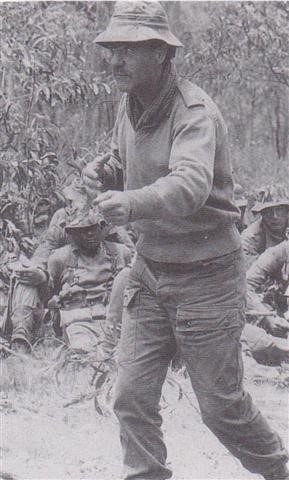
Possibly the most important part of their course for those in the graduating class, where they consolidated and practised the knowledge they had accumulated, it was equally important that their instructors were properly motivated and understood their task. This was a difficult period for the instructors with the switch from the close country warfare which they had been reared on and the open warfare requirement which was now the central theme, for which training had been switched from Yarram to Puckapunyal.
Chief Instructor Lt Col T.C. Bannister, himself one whose early training was in open warfare, reinforces to students the lessons which had been brought out in the exercise.
OCS Scrapbook 1973
As would be expected in a new school based largely on practical work, the prizes for academic subjects were limited to those of Tactics and the aggregate of the other military academic subjects. What is surprising is that, after expansion to the one year course and then the significant numerical expansion of the 1960s, it should have taken until 1971 for further prizes in Arms and Arts. From thereon, however, various corps and other organisations jumped on the bandwagon and other more specific prizes proliferated. The extension and specialisation of prizes resulted in redefining the subjects of the earlier ones, resulting in the following phases of awards:
The Tactics Prize originally awarded for drills and skills subjects, it was reallotted: 1971-76 Awarded to the cadet gaining the highest aggregate of marks for the following: Tactics and Minor Tactics
1977-85 Awarded to the cadet gaining the highest aggregate of marks in Tactics.
[from 1978 The Royal Australian Infantry Corps Prize for Tactics]
The Staff Prize
1952-85 Awarded to the cadet gaining the highest aggregate of marks for the following subjects [a selection of these applied at different times during the period]: Staff Duties, Intelligence, Organisation, Current Affairs, Military Law, Military History, Administration Peace, Administration War, Training, Methods of Instruction, ABC Warfare, Military and Social Etiquette.
The Arms Prize
1971-76 Awarded to the cadet gaining the highest aggregate of marks for the following subjects: Armour, Artillery, Engineers, Signals, Air Support.
1977-85 Awarded to the cadet gaining the highest aggregate of marks in the All Arms examination.
[from 1982 as The Field Marshal Sir Thomas Blamey Arms Prize.]
The Royal Australian Corps of Transport Prize for Logistics
1980-85 Awarded to the cadet gaining the highest mark in the Logistics examination.
The Arts Prize
1971-85 Awarded to the cadet gaining the highest aggregate of marks for the following subjects [a selection of these applied at different times during the period]: Communication Skills, Military History, Military Law, Logic, Government.
The Ronald Syme Prize
1977-82 Awarded to the cadet gaining the highest marks in Administration Peace, Administration War and Military Law.
1983-85 Awarded to the cadet gaining the highest marks in Peace Administration and Military Law.
The Everard Baillieu Prize
1974-82 Awarded to the cadet who makes the best written submission on the developing, understanding and co-operation and the essential human relationship between Australia and her neighbours.
1983-85 Awarded to the cadet gaining the highest marks for studies associated with an understanding of Australia’s role in world affairs, with particular emphasis on the South East Asian region.
The Royal Australian Army Ordnance Corps Prize
1982-85 Awarded to the cadet gaining the highest mark in Military History.
The Royal Australian Artillery Prize
1982-85 Awarded to the cadet gaining the highest aggregate of marks of those graduating to Artillery.
The Royal Australian Engineers Prize
1982-85 Awarded to the cadet gaining the highest aggregate of marks of those graduating to the Royal Australian Engineers.
The Royal Australian Corps of Signals Prize
1983-85 Awarded to the cadet gaining the highest aggregate of marks of those graduating to Signals.
The Ordnance Prize
1977-82 Awarded to the cadet gaining the highest aggregate of marks of those graduating into the Ordnance Corps.
The major longstanding military academic prizes were awarded as shown in Table 11.
Leadership
There could be little doubt that in an officer development course leadership development would be a primary objective. While such civilian management training courses as those at the Administrative Staff College could ignore this topic with equanimity in the idea that organisation, industrial relations manoeuvring and esoteric management theories could somehow cope with managing an organisation’s most valuable asset, the Army has long been aware of the vital place which leadership holds in making a structure work under the stresses of both active and peacetime service. Contrary to general civilian belief much reinforced by superficial media images, authoritarianism and punishment are not the basis of military discipline: the military leader, and in particular the junior leader has to persuade soldiers to work and carry on in difficult and often dangerous conditions and timings which neither civilian worker nor his union would tolerate; and while the reserve disciplinary powers are there, it is not possible to incarcerate all of a unit, and the soldiers are aware of this. Commanders must carry their subordinates along with them by persuasion and example, and the theory and skills of leadership were necessarily prime material to be laid before the disparate group of young men who provided the raw material of future leaders at all the Army’s officer producing establishments.
One theory of leadership which had some currency at OCS had it resting on a religious base. Successful leaders of the mould of Alexander, Julius Caesar, Napoleon or Zhukov would dissent, but those with strong personal faiths rarely admit other points of view, and theirs was the one which prevailed. In early 1961 the Chaplain Generals were brought to Portsea to conduct a character guidance course for both senior and junior classes; thereafter each junior class passed through this course of instruction, with from the 1970s a second round being added for those in their senior term. While this may have widened and improved the ethical standards and horizons of the students, the path to leadership was a different one.
More pragmatic instruction formed the core of leadership instruction within the course, and its scope and practice widened progressively and beneficially. Teaching of leadership in the army in the 1950s carried a degree of awkwardness as, surprisingly after two world wars, there was no coherent theory, the topic being treated by case studies of high profile achievers who were not necessarily good leaders, and by low level examples of leadership activities; two pages of Slim’s Defeat into Victory contained better material on this than the rest put together, as candidates for officer promotion examinations at the time found out. Then in the later 1950s this serious deficiency began to be met, firstly by the establishment of the desirable characteristics of a leader, which became a sure question in the promotion to captain examinations, accompanied by some serious analysis of the psychological factors underpinning its practice. While early commandants may have had some reservations on this latter development, it was inescapable that it become part of the picture and, combined with the practical side well understood but hitherto not articulated by successful unit commanders, a body of theory and practice was developed which could provide a coherent subject to teach in a course such as that at OCS (20).
This much achieved, assessment of cadets was another matter. A major difficulty was gaining objectivity and reality in a group of equals who were placed in a genuine control situation for only brief periods of time. Discussion groups discussing typical unit personnel management problems were no more than problem solving exercises which applied equally to logistics or training ones. Cadet actions during the normal conduct of School routine added little of real value in determining leadership ability, and to press this further could only result in playacting for the benefit of assessors; at one stage assessment even incorporated demerits for minor misdemeanors unrelated to any leadership criterion. Until mid-1974 there continued ‘a rather subjective leadership assessment system based on no logically derived rationale’, after which it was replaced by a modification of the system developed for OTU Scheyville. It established leadership qualities against which measurement criteria were applied and weighted to take account for the relative importance of the different qualities (21).
With an effective means of assessment, there remained its effective application, which could no more rely on happenings in the routine of Portsea than could the subjective system. Reality lay in genuine command situations, which meant field exercises; in the early 1980s these were increased in duration and two special exercises added for the junior class designed to give maximum exposure to individuals – a short arduous navigation and patrolling exercise and a week-long leadership exercise. So in its closing years Portsea had come to as effective an approach to perhaps its most important subject as was possible. The will had been there with all the earlier commandants and their senior staff, but the means had either not been apparent or acceptable. It was a nebulous topic for assessment, and one which experienced soldiers preferred to solve on the basis of their experienced judgement, but as expansion of the faculty both distanced the senior staff and diluted the experience of the officers in direct contact with the students, so this system had to be replaced by one which was about as objective as could be achieved, given the unavoidably subjective nature of the allocation of gradings (22).
As with the military academic subjects, it is surprising that it should have taken until 1966 when the prospect of their Chief of the General Staff reviewing the December graduation parade led the New Zealand Army Board to propose that it award a graduation prize for leadership to be called after itself, raising the question of whether trans-Tasman perceptions in this area were more acute or simply a CGS wish to provide a prize which was directed into the most obvious gap (23). Of course the Sword of Honour had been designed to fill this space, but right or wrong that was pre-ordained to go to the senior cadet, whose performance in the second half of the course did not necessarily give him the leadership assessment accolade. It provided recognition to whomever produced the most consistent performance in all facets of life over the year as assessed by a wide variety of instructors, unrelated to the politics of determining who would occupy the BSM’s position. And on top of this, there was the situation of uneven initial standards of experience and maturity. With an age spread of 18 to 26, and an experience spread of school-leavers to ex-senior non-commissioned officers, there was obviously scope to recognise improvers.
With the upcoming absorption of OCS into RMC it seemed appropriate to recognise the earlier closure and absorption of the other academies: the Officer Training Unit was therefore belatedly commemorated with the OTU Prize for improvement in leadership qualities during the course. The prizes for leadership were finally:
New Zealand Army Board Prize
1967-85 Awarded to the cadet gaining the highest marks in Leadership
[from 1971 as The New Zealand Chief of the General Staff’s Prize].
The Officer Training Unit Prize
1982-85 Awarded to the cadet who has shown the greatest improvement in leadership qualities during the course.
Awards for leadership are shown in Table 11.
Assessment and Review
The course commenced with a target of 10,000 points for all subjects; this was changed to 8,000 in 1957, and later to 7,500. The proportion allocated to various aspects was also varied, but was generally in the area of about one fifth to leadership, half to the military academic group and one third to drills and skills. The quota of marks, in combination or by subject, variously determined the order of merit in class, provided considerations for progress reviews, latterly by the Board of Studies, and gave scores for the award of prizes. Part subjective, part objective, it was a necessary tool in charting a cadet’s progress and providing the basis for adequate counselling. As well there were hurdles to be passed: entry into the senior class required a satisfactory standard of physical fitness and basic military subjects, and to graduate he had to meet the standard in all subjects unless the commandant was convinced that there were strong compensating reasons to overshadow specific deficiencies (24).
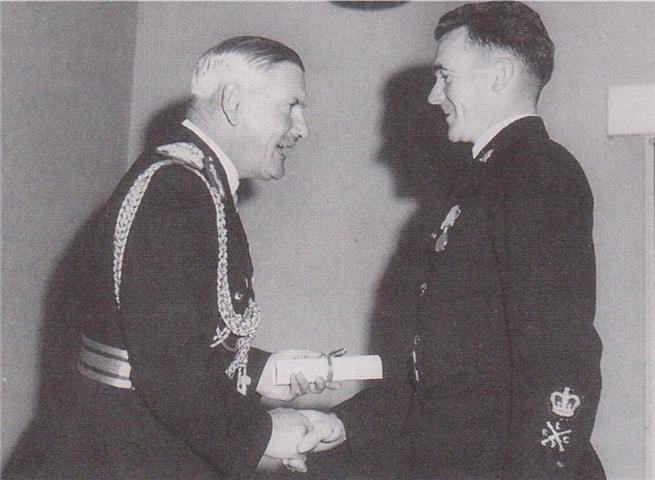
Reviewing officer for the mid-year graduation Maj Gen C.H. Finlay had a straightforward task, all the prizes being awarded to CSM E.J. Ellis in a not-to-be repeated performance.
When O/C R.L. Bricknell realised that Ellis was headed for a clean sweep and made a dash for the Field Prize, his adversary redoubled his efforts and took that one too. It was not unusual for one cadet to take a wide array of prizes in the earlier years until the range of prizes and cadets increased dramatically, when broader distribution became normal. The array of skills necessary was wide, and it was open to any to prove themselves the better in any of them.
Photo: E.J. Ellis
From 1957 the commandant was officially authorised to allow repeat of one term, junior or senior, where insufficient progress had been made or there had been prolonged absence through sickness. A decision for removal was based on disciplinary, academic failure or unsuitability to become an officer; initially a decision by the commandant as for any other army school, a problem with an overseas cadet led the Adjutant General/Chief of Personnel-Army to reserve such decisions for himself on the School’s recommendation. Looked on as a formality, some very late decisions on occasions caused a reaction from Army Office as to why the assessment system should be so tardy in responding. There was little reason short of a late disciplinary lapse of the most serious kind for this to occur in a 12 month course, and it is hard to understand why anyone so marginal as to require a late decision could be trusted to become an officer any more than a soldier who was unreliable in performance should be qualified as a journeyman tradesman. The assessment and review system was as fair as could reasonably be devised; it was a pity that it should have been marred by the theatrics of unnecessarily prolonged decisions.
Prizes were awarded for overall achievement; the first two are shown in Table 12:
Governor General’s Medal
1952-85 Awarded to the cadet graduating first in his class.
Military Board Prize
1955-64 Awarded for exemplary conduct and performance of duty; replaced by:
Sword of Honour
1964-85 Awarded to the cadet showing exemplary conduct and outstanding performance of duty.
The Peter Stuckey Mitchell Trust Competition
1971-85 A travelling scholarship in South East Asian countries awarded to the cadet who best displays the qualities of leadership, initiative, physical fitness, integrity, motivation, academic ability and the potential to become a senior commander in the Australian Army.
The terms of assessment for the Mitchell Trust competition demonstrate a remarkable hubris on the part of the School staff in accepting all of them as valid parameters. While the first group of qualities is reasonably measurable and a valid area for assessment by a training institution, the idea that any undergraduate course could pick a general officer (or a general manager of BHP or a university vice-chancellor) is incomprehensible. Officer graduates, no different from university graduates, are at the beginning of a long hard road of learning and performance development, and it was often found that the late improvers moved to the forefront of becoming successful leaders and managers. It was a notable failing of army colleges, including post-graduate ones, that they attempted to judge on issues beyond academic performance, when they had neither the mechanisms nor crystal balls with which to justify such excursions into possibilities and probabilities. This was recognised to a limited degree in 1973 when seniority on graduation from the officer training academies, which could have a far-reaching influence on graduates in the approach of military secretary staff to decisions made on them through their careers, ceased to reflect course results and switched to simple alphabetical listing. Assessment of course performance was designed simply to determine whether aspirants met the basic standard to become officers, and this change accepted that all had to prove themselves in the real world. It is notable that the two graduates to so far make general rank were neither at the top of their class nor major prize winners, and this is observable to a substantial degree with other senior graduates.
Instruction and Assessment
Instructional lecture
1953
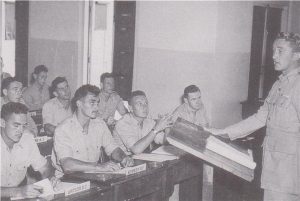
While much of the course content was practical and conducted in the field, some subjects were by nature covered by lectures. After the first pressure-cooked course, wherever possible this was effected by mutual instruction to give students the opportunity to practise instructional techniques and research material in preparation for the lecture.
Instructor Capt J.C.F . Moloney, in the usual cramped conditions of the early availability of lecture facilities, is delivering a lecture to the students of the third course which graduated in June 1953, from the front left:
R.J. Darlington, N.C. Kennedy, T.F.H. Walker, C.D. McConachy AJ. Corboy, N.W.J. McVilly, W.J. Murray, R.Y. Porter, S.R. Gerahty L.H. Shaw
Photo: N..J. McVilly
Map reading
1960
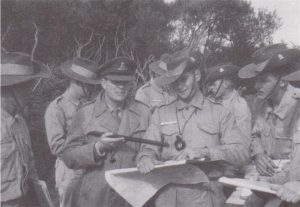
Map reading is one of the most basic and important stocks in trade of any officer, and was given emphasis by the School if not by the cadets. Map reading exercises involved students being bussed to various locations, orienting themselves on the ground and determining their position and that of other objects.
In control is Capt C.A. Cunningham who, although freely acknowledging his deficiencies in this subject as a cadet, was naturally made map reading and field sketching instructor on return to the School in 1959.
With him are O/Cs Surajit Shinawatra and A.J. Booth. The former was the only Thai student to graduate from OCS, and was a member of what has now become the wealthiest and most powerful family in Thailand; he did not survive to share that, being killed in action on the Thai-Laos border in 1973.
Photo: C.A Cunningham
Tactics instruction
Badcoe Hall 1972
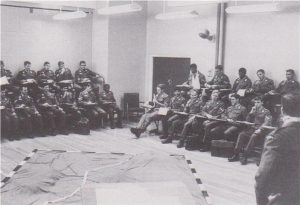
The theoretical basis of tactics had to be taught and exemplified in the classroom so that there was a clear understanding of the nature and techniques of field deployments and employment before attempting their practical application.
One of the techniques employed was the cloth model exercise, where a simulation of terrain, with opposing forces laid out on the model, provided a bird’s eye view and representation of a battlefield. Students were then required to consider and give solutions to problems, and then engage in critique and discussions of those solutions.
While not a plush, tiered theatre up to present day standards, the room in Badcoe Hall provided adequate space and flexibility for conversion to lecture facilities well ahead of the cramped rooms preceding its construction.
Australian Archives
Exercise debriefing
1970
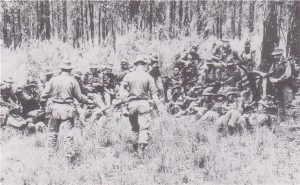
Part of the sequence of field training was a debriefing where instructors told the students where it went wrong. This was by no means a negative approach, as if an activity was completely bad, it was beyond making such comments. The purpose was to examine errors, find ways of correcting them, then trying it again to get it right.
In the hot seat were mostly students occupying the command positions, though inadequate performance by the rest did not go unnoticed. Remedial training was at. the core of OCS’s technique. Gone were the days of do it once, pass or fail. It was up to instructors to identify individual or group weaknesses and rectify them through critique, reinforcing earlier instruction, and repractising to remove faults and get students to a capable level. Only those unable or unwilling to respond were destined for failure.
OCS Scrapbook 1970
References
- MP927 A259/18/29 Military Board Agendum 10/1981 p3; Senior Instructor R.S. Garland states he copied the syllabus from Mons/Eton Hall; however those were of three months duration.
- AWM MSS 1479AHQ 182/R2/12 of31 July 1967 Annex A.
- AWM MSS 1479AHQ 182/R2/12 of 31 July 1967 DPA Paper, p2.
- Wrangle C.G. ed ‘The Major General Sir James Harrison Memorial Lectures’, p3.
- AWM MSS 1479AHQ 182/R2/12 of 31 July 1967, p7-9.
- RMC Archives OCS Standing Orders Part 7 The Staff Handbook, p1-1.
- AA B2453/1 R133/1/16 Brief on OCS 15 November 1965; AA B2453/1 R133/1/16 of 15 November 1965 Annex B; AWM 1479520/1142 of July 1977; OCS Standing Orders 1981 Amendment No 13 February 1983 February 1983.
- Table 2, Table 9.
- AA B2354/1 R723/1/1 of 31 July 1970; Interviews M. Howe; Letters M.L. Keam, A.A. Nicolic; AA B235411 R723/1/1 of 7 August 1973.
- Interviews I.G. Hands, I Throssell; AA B2354/1R723/1/1 of December 1955; Interviews G.D. Burgess; AA B2354/1 234/4/5 OCS Report December 1962.
- AA B2354/1 R723/1/1, 234/4/5 OCS Reports 1952 onwards.
- AA B2354/1 R723/1/1, 234/4/5 OCS Reports 1955 onwards.
- AA B2354/1R723/1/1, 234/4/5 OCS Reports 1952-57.
- AA B2354/1 R723/1/1, 234/4/5 OCS Reports 1957-75.
- AA B2354/1 R723/1/1, 234/4/5 OCS Reports 1952-69.
- AA B235411 R723/1/1 OCS Reports 1972-75.
- AA MP927 A259/18/29 Military Board Agendum 10/1951 p3; also Chapter 7.
- B2354/1 R723/1/1, 234/4/5 OCS Reports 1955-67, 1974; R284/1/1 of 28 February, 6 March 1968, 21 January 1969.
- AA B2354/1 R723/1/1, 234/4/5 OCS Reports 1956, 1966; RMC Archives Miscellaneous OCS Commandants Graduation Addresses June 1968; OCS Journal 1971 onwards illustrate ongoing deficiencies.
- Handbook on Leadership; RMC Archives Commandants Graduation Addresses 12 December 1956.
- AA B2354/1 R560/1/2 of 1975.
- AA B2354/1 R441/1/1 of 16 October 1983.
- OCS Journal June 1972, p35.
- 24. AA B2354/1 R723/1/1 of December 1957; OCS Standing Orders Annex G to Chapter 7.